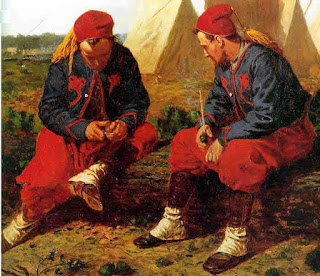 |
| Duryea's Zoauves: 5th New York |
 |
| Standard U.S. Uniform |
Both blue and grey were official uniforms of the US Army during the 1850s. Grey was more popular in the South and Blue was favored by Northern militia. At the start of the war, there were a few Southern units wearing blue and several Northern units in grey. It caused a lot of confusion, especially in the war’s early battles. Most militia eventually adopted the regulation uniform chosen by their side.
A comical problem was the matter of drill manuals. Up until 1861, the Army used Hardee’s drill manual. When the Civil War erupted, Hardee joined the Confederacy. The Union came up with a "new" manual by a fellow named Silas. It was almost a carbon copy of Hardee’s book. Other drill books were used, especially translations of French manuals. French Zouave manuals were used by several units.
Even those who adopted regulation colors often had unique accouterments and trim. There were various types of jacket available, from sack coats to shell jackets. The same went for headgear. Colors also varied. For instance, sharpshooter units preferred hunter green, a color similar to that used by German Jaeger troops. And making matters even more confusing were the Zouaves!
 |
| Confederate Infantry |
French military fashion influenced many armies throughout the 19th century. After their successful foray into North Africa, several French units adopted the Zouave attire. These were based on ornate North African uniforms. Zouaves and Turcos were elite sharpshooter units in the French army. They were copied by several armies, including the Papal States and the Turks. American armies on both sides had their own Zouave units. Often, these were financed by a wealthy organizer or were bought by units with affluent members.
 |
| Riflemen: Butternut, Confederate Grey, Union Blue |
Several Zouave units actually copied French chasseurs, another colorful branch of the French army. The origins of the chasseurs were European rather than North African. Units attired in Chasseur and Zouave uniforms came from New York, New Jersey, Pennsylvania, Maryland, Illinois, and Louisiana, among others. Many eventually dropped the Zouave clothes in exchange for regulation uniforms as the war progressed. Some remained in the fancy uniforms until the war’s end.
 |
| Artillerymen |
The end of the Civil War saw a standardization of uniforms. Several militias kept their fancy uniforms for parade and special events. The campaign uniform was the same as that of the regular Army. Though a brown uniform was authorized and issued in 1898, blue uniforms remained in use in the US Army until 1912.
 |
| Zouaves (Union) |
No comments:
Post a Comment